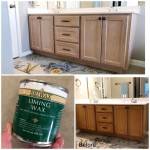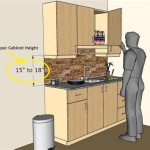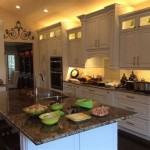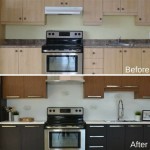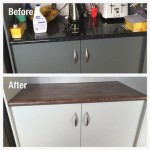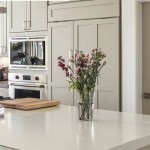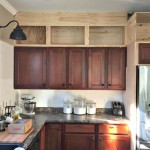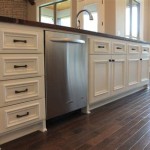Here's an article focusing on painting gloss kitchen doors, formatted as requested: ```html
Painting Gloss Kitchen Doors: A Comprehensive Guide
Gloss kitchen doors offer a sleek and modern aesthetic, reflecting light and enhancing the overall brightness of a kitchen space. However, gloss surfaces are prone to showing imperfections, scratches, and can become dated over time. Instead of a complete kitchen renovation, painting existing gloss doors presents a cost-effective and environmentally sound alternative. This article provides a comprehensive guide to successfully painting gloss kitchen doors, covering preparation, material selection, application techniques, and troubleshooting common issues.
The primary challenge in painting gloss surfaces lies in achieving proper adhesion. Glossy finishes are inherently non-porous, making it difficult for paint to grip the surface. Without adequate preparation, the paint is likely to chip, peel, or scratch easily, negating the intended improvements and potentially damaging the underlying door material. Therefore, meticulous preparation is paramount for a durable and visually appealing finish.
Key Point 1: Thorough Preparation is Essential
The preparation phase is the most crucial aspect of painting gloss kitchen doors. It involves cleaning, degreasing, sanding, and priming the surfaces to create a suitable base for the new paint. Skipping or inadequately completing any of these steps will compromise the final result.
Cleaning: Begin by thoroughly cleaning the doors with a degreasing cleaner specifically designed for kitchen surfaces. This will remove grease, grime, and food splatters, which can impede paint adhesion. Consider using a solution of warm water and trisodium phosphate (TSP) if the doors are heavily soiled. Ensure the doors are completely dry before proceeding to the next step.
Removing Hardware: Remove all door handles, knobs, hinges, and any other hardware. This will allow for a cleaner paint application and prevent paint from getting on the hardware. Label each piece of hardware and its corresponding location on the door to facilitate reassembly. If possible, remove the doors from their hinges entirely to make the painting process easier and more manageable. Laying the doors flat allows for more consistent paint application and reduces the risk of drips.
Sanding: Sanding is essential to create a mechanical key for the paint to adhere to. Use a medium-grit sandpaper (around 120-180 grit) to lightly scuff the entire surface of the doors. The goal is not to remove the existing gloss finish entirely, but rather to create a slightly rough texture that the primer can bond to. Pay particular attention to edges and corners, as these areas are more prone to chipping. After sanding, thoroughly remove all sanding dust with a tack cloth or a damp cloth. Allow the doors to dry completely.
Priming: Apply a high-quality primer specifically designed for glossy surfaces. An adhesion primer is crucial for ensuring the paint properly bonds to the substrate. Follow the manufacturer's instructions for application and drying times. Consider using a stain-blocking primer if there are any stains or discoloration on the doors, as these can bleed through the new paint. Apply the primer in thin, even coats to avoid drips and runs. Allow the primer to dry completely before proceeding to the painting stage and lightly sand the primed surface with fine grit sandpaper (220-grit or higher) to create an ultra smooth application surface. Remove any sanding dust.
Key Point 2: Selecting the Right Paint and Tools
Choosing the appropriate paint and application tools is critical for achieving a professional-looking finish on gloss kitchen doors. The type of paint, the sheen level, and the application method will all influence the final outcome.
Paint Type: Acrylic latex paints are generally recommended for painting kitchen cabinets due to their durability, ease of application, and low VOC (volatile organic compound) content. Alkyd paints (oil-based) offer excellent durability and a hard, smooth finish, but they require longer drying times, emit more VOCs, and are more difficult to clean up. Consider using a paint specifically formulated for cabinets and furniture, as these paints are designed to withstand the wear and tear of everyday use. For particularly demanding environments, consider a two-part epoxy paint. However, these are more demanding to apply and often have a stronger odor.
Sheen Level: While high-gloss paint is often associated with kitchen cabinets, it can accentuate imperfections in the surface. A semi-gloss or satin finish is generally preferred, as it provides a good balance between durability, ease of cleaning, and visual appeal. Matte finishes are not recommended for kitchen cabinets, as they are difficult to clean and tend to show fingerprints and stains easily. Experiment with samples of different sheens on a test area or spare piece of material before committing to the entire project.
Application Tools: Use high-quality paint brushes, rollers, or sprayers to apply the paint. A fine-bristle brush is ideal for achieving a smooth finish on trim and edges. A foam roller is a good choice for painting larger flat surfaces, as it minimizes stippling. A paint sprayer offers the most even and professional-looking finish, but it requires more skill and preparation, including masking off surrounding areas to prevent overspray. If using a sprayer, be sure to use a paint specifically formulated for spraying and thin the paint according to the manufacturer's instructions. Choose brushes with synthetic (nylon or polyester) bristles for use with latex paints, as natural bristles will absorb water and become limp.
Safety Equipment: Always wear appropriate safety equipment when painting, including gloves, eye protection, and a respirator mask. This is especially important when using sprayers or solvent-based paints, which can release harmful fumes. Ensure adequate ventilation in the work area by opening windows and using fans.
Key Point 3: Proper Application Techniques for a Flawless Finish
Even with meticulous preparation and the right materials, improper application techniques can result in an uneven, unprofessional-looking paint job. Following these techniques will help ensure a smooth, durable, and visually appealing finish.
Applying Thin Coats: Apply the paint in thin, even coats, allowing each coat to dry completely before applying the next. Thick coats of paint are more prone to drips, runs, and sagging. Multiple thin coats will result in a smoother, more durable finish. Follow the manufacturer's instructions for drying times. Sanding lightly between coats (with fine-grit sandpaper, 220-grit or higher) can help to remove any imperfections and create a smoother surface for the next coat.
Avoiding Drips and Runs: Pay close attention to edges, corners, and other areas where paint is likely to accumulate. Wipe away any drips or runs immediately with a clean, damp cloth. If the drips or runs have already dried, sand them down smooth before applying the next coat of paint.
Maintaining a Wet Edge: When painting large surfaces, maintain a "wet edge" to prevent lap marks. This means overlapping each brushstroke or roller pass slightly with the previous one while the paint is still wet. This will ensure a seamless transition between strokes and prevent the formation of visible lines.
Proper Drying Time: Allow the paint to dry completely according to the manufacturer's instructions before reassembling the doors and hardware. Rushing the drying process can result in a soft, easily damaged finish. Humidity and temperature can affect drying times, so allow for extra drying time in humid or cold conditions.
Reassembly and Curing: Once the paint has fully cured (typically several days), carefully reassemble the doors and hardware. Use new screws if the old ones are stripped or damaged. Avoid using harsh cleaning products on the painted surfaces for at least a week after reassembly, as the paint will continue to harden and cure during this time.
Troubleshooting Common Issues: Even with careful planning and execution, problems can arise during the painting process. Common issues include brush marks, orange peel texture, and paint peeling. Brush marks can be minimized by using a high-quality brush and applying the paint in thin, even coats. Orange peel texture can be caused by applying the paint too thickly or by using a paint that is not properly thinned. Paint peeling is usually caused by inadequate surface preparation. Address these issues by sanding down the affected areas and reapplying the paint using proper techniques.
By following these guidelines, homeowners can successfully paint gloss kitchen doors and achieve a professional-looking finish. The key to success lies in meticulous preparation, careful material selection, and proper application techniques. A well-executed paint job can transform the look of a kitchen, adding value and enhancing the overall aesthetic appeal.
```
How To Create A High Gloss Kitchen

Can You Paint High Gloss Kitchen Cupboards Wespray

Can Kitchen Spray Be Used To Cover A Gloss Wespray

What Is The Best Spray Paint On Kitchen Cabinets

How To Paint Laminate Kitchen Cabinets Perfect Finish Tips

How To Paint Kitchen Cupboard Doors The Hub

How To Change Colour Of Gloss Kitchen Doors And Drawers

Doors And High Gloss Painting Transitional Kitchen New York By Finglas Houzz

Best Paint For Your Next Cabinet Project The Home Depot

How To Paint Kitchen Cabinets Like The Pros
Related Posts

